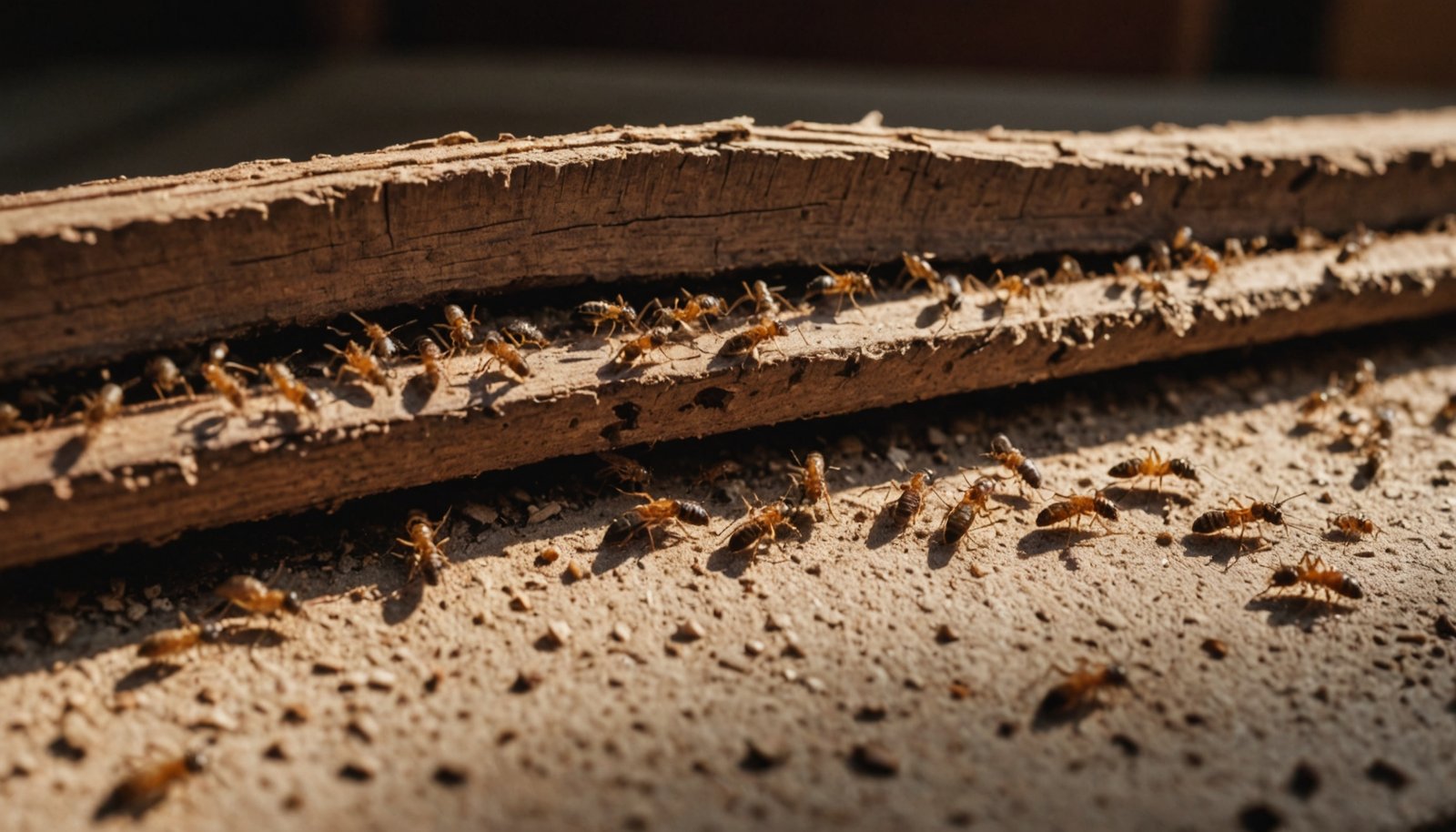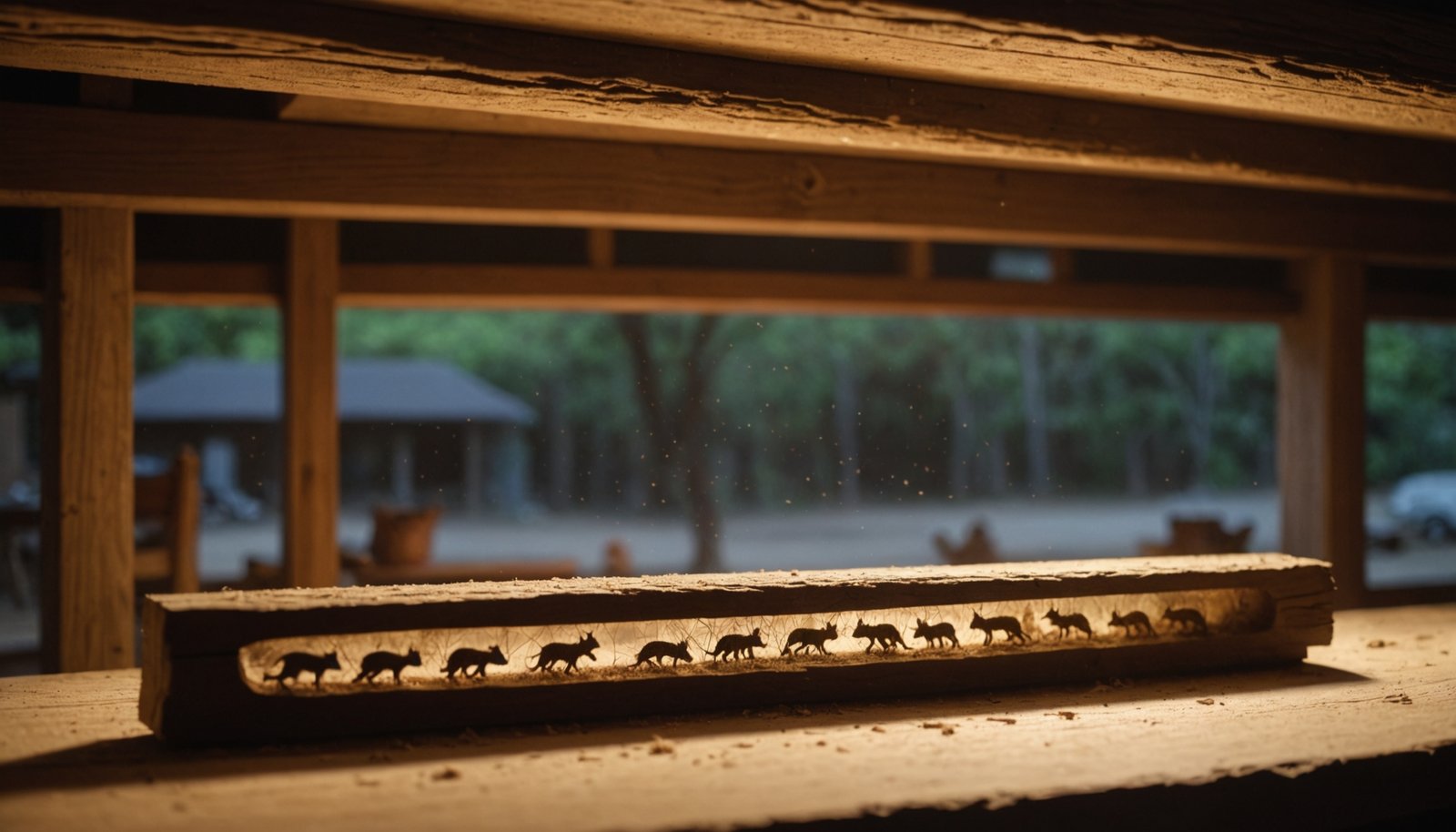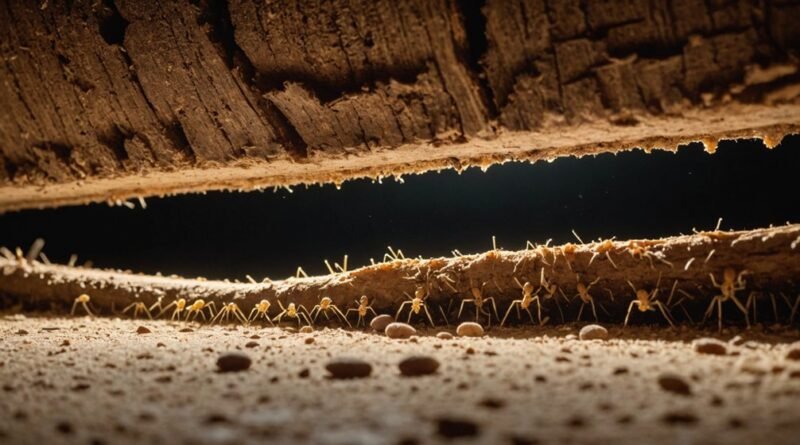Are Termites Dangerous? Health Risks for Families & Pets
Yes—termites can affect more than wood. They spread germs via droppings and dust, irritate airways with spores and particles, and can trigger allergies and asthma in you and your pets. Rare bites cause mild swelling and itching. Hidden damage weakens floors, decks, and roofs, creating safety risks. Older chemical treatments can harm people, pets, and the environment, so use certified pros and safer options. Watch for pet itching and watery eyes. Learn how to protect your home, family, and pets next.
Key Takeaways
- Termites don’t spread classic human diseases, but their droppings and dust carry bacteria and fungi that can irritate eyes, skin, and mouths.
- Airborne particles and spores from termite activity can trigger allergies and worsen asthma, especially indoors via HVAC circulation.
- Prolonged exposure may inflame airways, causing sneezing, wheezing, coughing, and chest tightness in sensitive people and pets.
- Bites are rare and mild; clean with soap and water and seek care if swelling, pain, or symptoms persist beyond two days.
- Structural damage from termites can create safety hazards; use protective gear and hire licensed professionals for inspection and treatment.
How Termites Can Spread Germs and Trigger Illness

Although termites don’t bite or sting people, they can still spread germs and trigger illness by moving microbes and irritants through your home. Colonies harbor bacterial and fungal pathogens that hitchhike on termites, droppings, and dust. If these microbes reach cuts, eyes, or your mouth, they can cause infections.
Termites don’t bite, but they can ferry germs and irritants that spark infections and illness.
Fungal spores from nests or frass become airborne, irritating your airways when you breathe them in. Termite activity also fosters moisture and decomposed wood, creating prime conditions for mold and mildew. Those fungi release spores that degrade indoor air quality and can worsen respiratory issues.
Dust from damaged wood mixes with tiny fecal particles, adding irritants that trigger coughing, sneezing, and runny noses, and can aggravate asthma or bronchitis. Termites can compromise plumbing, letting contaminants enter water. Microbes spread along pipes and surfaces, raising risks of gastrointestinal illness. Termites may also disturb asbestos, releasing hazardous fibers that increase long-term risks of lung disease.
Prompt repairs, targeted termite control, and regular inspections reduce these transmission pathways and protect your household.
Allergies to Termite Saliva and Droppings

You might notice sneezing, wheezing, itchy eyes, or skin rashes after contact with termite saliva or frass, especially if you have asthma or other allergies.
Watch for nasal congestion and chest tightness that worsen indoors, which can signal airborne termite allergens.
Reduce exposure by avoiding direct contact with debris, improving ventilation and filtration, and scheduling professional inspection and control. Consider booking a professional inspection since HiCare offers a free thorough inspection to identify termite infestations and assess the problem.
Common Allergy Symptoms
Even a small termite infestation can trigger noticeable allergy symptoms when saliva, droppings (frass), and shed skins become airborne and enter your lungs, eyes, or contact your skin.
You may develop coughing, wheezing, chest tightness, shortness of breath, or an asthma flare when you inhale these proteins. Sneezing, a runny or stuffy nose, and sinus congestion are common and often mimic a cold. Airborne particles can circulate through HVAC systems, spreading allergens throughout your home. People with a history of allergies or asthma are at higher risk of developing symptoms from termite exposure.
Skin contact with frass or saliva can cause itching, redness, hives, rashes, burning, or swelling—especially after handling infested wood.
Rare bites or stings may produce painful swelling and intense itching. Eyes can turn red, itchy, watery, and irritated, resembling dust mite reactions and contributing to allergic conjunctivitis, particularly with prolonged indoor exposure.
Reducing Exposure Risks
While termites stay hidden, their saliva, frass, and shed skins can quickly contaminate indoor air, so focus on cutting what you breathe and touch.
Swap HVAC filters regularly and add HEPA air purifiers to trap microscopic particles. Keep indoor humidity low with dehumidifiers, especially in basements and crawl spaces, and fix leaks to deter termites and mold. Mold spores inside homes are significant contributors to asthma symptoms.
Clean often: vacuum with a HEPA-equipped machine, damp-dust surfaces, and promptly remove termite-damaged wood and debris.
Don’t disturb infested wood without precautions. Seal cracks and crevices to block entry and allergen buildup.
When inspecting or treating, wear gloves, long sleeves, and an N95. Avoid DIY pesticides; ventilate treated areas and hire licensed pros.
Schedule routine inspections, monitor for mud tubes and frass, and use integrated pest management to reduce ongoing exposure.
Asthma and Respiratory Irritation From Airborne Particles

Although termites rarely come to mind as respiratory triggers, their activity releases microscopic particles—frass (droppings), shed skins, wood dust, and enzyme-rich saliva—that can become airborne, circulate through HVAC systems, and irritate your airways.
These fine particles act like allergens, provoking sneezing, itchiness, coughing, wheezing, and, in sensitive people, severe breathing distress. They can disrupt the epithelial lining of your airways, sparking inflammation that worsens asthma. Professional pest control can help by reducing these respiratory hazards through targeted, environmentally mindful treatments.
Airborne termite particles inflame airways—triggering sneezing, wheezing, and, in sensitive people, severe breathing distress
Termite droppings may also contain protozoal cysts from gut symbionts. When you inhale them, they can aggravate airway inflammation and intensify asthma symptoms.
Research links termite dust in infested buildings with increased asthma flares, likely through both allergic pathways (enzymatic proteins) and non-allergic pathways (microbial components).
Termite-damaged wood sheds additional irritant dust that heightens mucus production and aggravates bronchitis and asthma.
Moist, damaged wood also fosters mold, adding spores that compound respiratory problems. If you have asthma or chronic lung disease, prolonged exposure makes symptoms harder to control.
Bite Reactions and When to Seek Medical Care
Surprised to find a small red mark after spotting termites? Termites rarely bite people, and when they do—usually soldier termites defending the colony—the reaction is mild. You’ll typically see a single, small red spot with slight swelling, brief redness, light itching, or tenderness. It shouldn’t form welts or clusters, and discomfort is minimal.
Clean the area with soap and water right away. Apply a cold compress to ease swelling. For itch, use calamine or a low-strength hydrocortisone cream; an oral antihistamine can help if you’re sensitive. Watch the spot for 24–48 hours.
Seek medical care if redness, swelling, or pain lasts longer than two days, or if you notice spreading redness, pus, increasing pain, or warmth—signs of infection.
Get urgent help for systemic symptoms like shortness of breath, dizziness, or lightheadedness. If you’re unsure it’s a termite bite, consult a clinician and, if possible, save the insect for identification.
Structural Damage and Hidden Safety Hazards
Termite damage can quietly undermine beams, joists, and floors, so you may be living with compromised structural integrity without obvious signs.
That hidden weakening raises collapse risks under decks, stairs, and sagging roofs, endangering your family and pets.
If you suspect damage, prioritize safety during inspections and repairs by limiting access, using protective gear, and calling licensed professionals.
Compromised Structural Integrity
Few household threats undermine safety as quietly as a termite-infested structure. When termites target beams, joists, and support pillars, they erode load-bearing capacity, leading to sagging floors, uneven surfaces, and stressed foundations. Colonies can consume about a pound of wood per day, so unseen internal damage accumulates fast, often for years before you notice visible clues. Roof trusses and rafters aren’t spared; compromised roofing timbers invite leaks, secondary interior damage, and costly reconstruction.
| Issue | What it means for you |
|---|---|
| Load-bearing damage | Reduced safe load capacity; higher collapse risk |
| Roof compromise | Sagging, leaks, and unstable roof system |
| Doors/windows | Warped frames, poor security, air leakage |
| Flooring/subfloor | Soft spots, warping, trip hazards, weakened support |
Timely assessment with moisture meters and boroscopes helps quantify damage and prevent escalating costs and property value loss.
Hidden Collapse Hazards
While sagging floors and warped frames hint at trouble, the greater threat often hides inside the wood you trust to hold your home up. Termites eat from the inside out, leaving surfaces intact while hollowing beams, posts, and sill plates. Tap suspect wood; a hollow, resonant sound signals internal loss.
Watch for bulges, blistered or uneven paint, and warping—warning signs of instability.
Subterranean termites mask movement with mud tubes, reaching floor supports, columns, porch decks, stairways, and basement walls. Damage can advance out of sight until a wall, ceiling, or load-bearing member fails under normal use.
Termites also create hidden hazards around utilities. Tunneling can nick wiring insulation, spark shorts, or even fires, and compromise insulation—reducing efficiency and releasing irritating dust and fibers.
Safety During Repairs
Even before you pick up a pry bar, treat termite repairs like a high‑risk operation. Tunnels and galleries weaken joists, beams, and studs—often behind walls, ceilings, and subfloors—so a small cut can trigger a collapse.
Subterranean termites love rim and floor joists, the very spots you’ll open first. Damage often spreads into plaster, drywall, and insulation, complicating scope and cost.
De‑energize affected circuits and have a licensed electrician inspect wiring; termites can nick insulation and spark fires.
Shore damaged areas before removal, ventilate well, and wear eye, respiratory, and skin protection to avoid dust, spores, and residues. Keep kids and pets away; noise, debris, and allergens can harm them.
Get an extensive inspection, expect $3,000–$3,300 averages, and plan for added time if hidden hazards emerge.
Chemical Treatments: Risks, Regulations, and Safer Options
Although chemical termiticides can stop destructive infestations, they carry real trade-offs you should weigh carefully.
Older chlorinated cyclodienes like chlordane, heptachlor, aldrin, and dieldrin persist in soil and bodies, can trigger headaches, dizziness, tremors, or seizures, and raised cancer concerns in animal studies.
Their environmental footprint is heavy: they contaminate soil and water, bioaccumulate through food webs, and can harm beneficial insects, birds, and aquatic life.
Production and misuse also add air pollution and climate impacts.
Today, the EPA and state regulators restrict high-risk termiticides and promote safer options.
You’re responsible for compliant use—and potentially liable for harm from improper or legacy chemicals on your property.
Look for treatments that work while minimizing exposure and contamination.
1) Verify products are EPA-registered and approved under current state rules.
2) Choose targeted delivery (baits, spot treatments) over broad soil saturation.
3) Consider bistrifluron baits—high efficacy, insect-specific, minimal bioaccumulation.
4) Hire certified pros who document labels, dosages, and disposal.
Pet Health Concerns: Allergies, Toxic Exposures, and Bites
Because your pets share the same air and surfaces you do, termite activity can indirectly trigger itching skin, sneezy noses, and irritated eyes by stirring allergenic dust, debris, and mold.
When termites tunnel through wood or soil, they release particulates that circulate through vents and settle on beds, floors, and fur. Sensitive pets may react to termite saliva or droppings (frass), much like they do to dust mite proteins.
Watch for allergy signs: persistent scratching or licking, red skin, watery eyes, sneezing, and hot spots—often around ears, face, paws, armpits, and groin.
Ongoing exposure can aggravate atopic dermatitis or asthma and increase risk of secondary skin infections from scratching.
Termite bites are rare and usually occur only if an insect is handled. They’re not venomous but can cause minor localized irritation.
If your pet chews or licks a bite, irritation can worsen and bacteria may enter, leading to infection.
Preventive Steps to Protect Your Home, Family, and Pets
While termites often stay out of sight, you can block their favorite routes and conditions with a few targeted habits. Keep wood lifted, keep things dry, seal gaps, and partner with pros when needed. These steps protect your home’s structure and reduce allergens and pesticide risks for kids and pets.
- Eliminate wood-to-soil contact
- Maintain at least 6 inches of clearance for siding, frames, and structural wood. Regrade soil, pull mulch back, and trim lattice. Don’t trust embedded posts; they can bridge into soil. Even pressure-treated wood needs sealed cuts.
- Control moisture near foundations
- Extend downspouts, add splash blocks, and fix leaks. Grade soil to drain away and avoid sprinklers that pool water near the foundation.
- Seal entry points and remove food
- Caulk cracks, repaint exterior wood, screen vents, and clear firewood, stumps, and debris. Inspect reclaimed lumber.
- Use professional barriers and treatments
- Consider liquid soil treatments, monitored baits, and wood treatments. Pre-treat during construction for long-term protection.
Conclusion
Termites aren’t just a property problem—they can affect your family’s and pets’ health. You’ll reduce risks by spotting signs early, fixing moisture issues, and sealing entry points. Keep dust down, vacuum droppings safely, and use certified pros who follow safer, regulated treatments. If bites, rashes, wheezing, or pet symptoms appear, call a doctor or vet. With smart prevention, prompt repairs, and pet-safe controls, you’ll protect your home’s structure and the people and animals who live in it.

